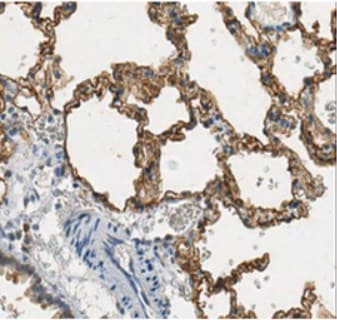Anti-Aquaporin 5 antibody (ab78486)
Key features and details
- Rabbit polyclonal to Aquaporin 5
- Suitable for: IHC-P, WB
- Reacts with: Mouse, Rat
- Isotype: IgG
Overview
-
Product name
Anti-Aquaporin 5 antibody
See all Aquaporin 5 primary antibodies -
Description
Rabbit polyclonal to Aquaporin 5 -
Host species
Rabbit -
Tested applications
Suitable for: IHC-P, WBmore details -
Species reactivity
Reacts with: Mouse, Rat -
Immunogen
A 17 amino acid synthetic peptide corresponding to the carboxy terminus of rat Aquaporin 5
-
General notes
The Life Science industry has been in the grips of a reproducibility crisis for a number of years. Abcam is leading the way in addressing this with our range of recombinant monoclonal antibodies and knockout edited cell lines for gold-standard validation. Please check that this product meets your needs before purchasing.
If you have any questions, special requirements or concerns, please send us an inquiry and/or contact our Support team ahead of purchase. Recommended alternatives for this product can be found below, along with publications, customer reviews and Q&As
Properties
-
Form
Liquid -
Storage instructions
Store at +4°C short term (1-2 weeks). Store at -20°C or -80°C. Avoid freeze / thaw cycle. -
Storage buffer
Preservative: 0.05% Sodium azide
Constituent: PBS -
 Concentration information loading...
Concentration information loading... -
Purity
Immunogen affinity purified -
Clonality
Polyclonal -
Isotype
IgG -
Research areas
Images
-
Anti-Aquaporin 5 antibody (ab78486) at 0.1 µg/ml + Rat salivary gland tissue lysate
Secondary
Goat Anti-Rabbit IgG secondary antibody conjugated to HRP
Predicted band size: 24 kDa
-
 Immunohistochemistry (Formalin/PFA-fixed paraffin-embedded sections) - Anti-Aquaporin 5 antibody (ab78486)
Immunohistochemistry (Formalin/PFA-fixed paraffin-embedded sections) - Anti-Aquaporin 5 antibody (ab78486)Immunohistochemistry (Formalin/PFA-fixed paraffin-embedded sections) staining Aquaporin 5 with ab78486 (1/2000) in rat lung. An anti-Rabbit secondary antibody and HRP-DAB was used. Tissues were processed using heat-induced epitope retrieval.
-
 Immunohistochemistry (Formalin/PFA-fixed paraffin-embedded sections) - Anti-Aquaporin 5 antibody (ab78486)
Immunohistochemistry (Formalin/PFA-fixed paraffin-embedded sections) - Anti-Aquaporin 5 antibody (ab78486)Immunohistochemistry (Formalin/PFA-fixed paraffin-embedded sections) staining Aquaporin 5 with ab78486 (1/500) in mouse trachea tissue. An anti-Rabbit secondary antibody and HRP-DAB was used. Tissues were processed using heat-induced epitope retrieval.











